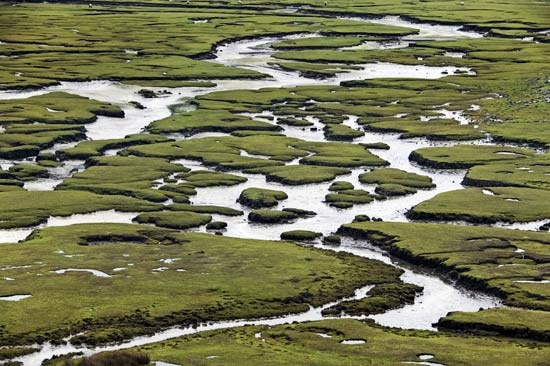peat
fuel
 an organic fuel consisting of spongy material formed by the partial decomposition of organic matter, primarily plant material, in wetlands (wetland) such as swamps, muskegs, bogs, fens, and moors. The development of peat is favoured by warm, moist climatic conditions; however, peat can develop even in cold regions such as Siberia, Canada, and Scandinavia. Peat is only a minor contributor to the world energy supply, but large deposits occur in Canada, China, Indonesia, Russia, Scandinavia, and the United States. Major users include Finland, Ireland, Russia, and Sweden.
an organic fuel consisting of spongy material formed by the partial decomposition of organic matter, primarily plant material, in wetlands (wetland) such as swamps, muskegs, bogs, fens, and moors. The development of peat is favoured by warm, moist climatic conditions; however, peat can develop even in cold regions such as Siberia, Canada, and Scandinavia. Peat is only a minor contributor to the world energy supply, but large deposits occur in Canada, China, Indonesia, Russia, Scandinavia, and the United States. Major users include Finland, Ireland, Russia, and Sweden.The formation of peat is the first step in the formation of coal. With increasing depth of burial and increasing temperature, peat deposits are gradually changed to lignite. With increased time and higher temperatures, these low-rank coals are gradually converted to subbituminous (subbituminous coal) and bituminous coal and under certain conditions to anthracite.
Peatification is influenced by several factors, including the nature of the plant material deposited, the availability of nutrients to support bacterial life, the availability of oxygen, the acidity of the peat, and temperature. Some wetlands result from high groundwater levels, whereas some elevated bogs are the result of heavy rainfall. Although the rate of plant growth in cold regions is very slow, the rate of decomposition of organic matter is also very slow. Plant material decomposes more rapidly in groundwater rich in nutrients than in elevated bogs with heavy rainfall. The presence of oxygen (aerobic conditions) is necessary for fungal and microbial activity that promotes decomposition, but peat is formed in waterlogged soils with little or no access to oxygen (anaerobic conditions), largely preventing the complete decomposition of organic material. The formation of abundant peat was not possible before land plants developed and spread widely during and after the Devonian Period (beginning approximately 360 million years ago).
Peats may be divided into several types, including fibric, coarse hemic, hemic, fine hemic, and sapric, based on their macroscopic, microscopic, and chemical characteristics. Peat may be distinguished from lower-ranked coals on the basis of four characteristics: peats generally contain free cellulose, more than 75 percent moisture, and less than 60 percent carbon, and they can be cut with a knife. The transition to brown coal takes place slowly and is usually reached at depths ranging from 100 to 400 m (approximately 330 to 1300 feet).
Peat is usually hand-cut, although progress has been made in the excavation and spreading of peat by mechanical methods. Peat may be cut by spade in the form of blocks, which are spread out to dry. When dry, the blocks weigh from 0.34 to 0.91 kg (0.75 to 2 pounds). In one mechanized method, a dredger or excavator digs the peat from the drained bog and delivers it to a macerator (a device that softens and separates a material into its component parts through soaking), which extrudes the peat pulp through a rectangular opening. The pulp is cut into blocks, which are spread to dry. Maceration tends to yield more uniform shrinkage and a denser and tougher fuel. Hydraulic excavating can also be used, particularly in bogs that contain roots and tree trunks. The peat is washed down by a high-pressure water jet, and the pulp runs to a sump. There, after slight maceration, it is pumped to a draining ground in a layer, which, after partial drying, is cut up and dried further.
Dried peat burns readily with a smoky flame and a characteristic odour. The ash is powdery and light, except for varieties that have a high content of inorganic matter. Peat is used for domestic heating purposes and forms a fuel suitable for boiler firing in either briquetted or pulverized form. It also has been used to produce electricity.
- gold-exchange standard
- goldeye
- Goldfaden, Avrom
- Goldfield
- goldfinch
- goldfish
- Goldhaber, Maurice
- Goldie, Sir George
- Goldin, Daniel Saul
- Golding, Louis
- Golding, Sir William
- Goldin, Nan
- gold leaf
- Goldman, Emma
- Goldman, Eric Frederick
- Goldmann, Nahum
- Goldmark, Josephine Clara
- Goldmark, Karl
- Goldmark, Peter Carl
- Goldoni, Carlo
- gold processing
- gold reserve
- gold rush
- Goldsboro
- Goldschmidt, Hans